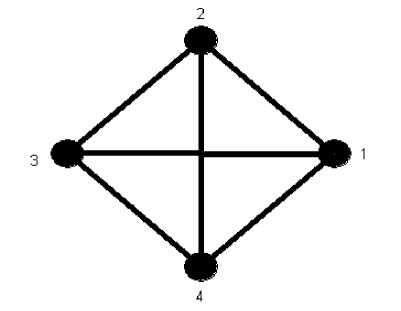T
tot
N!
(N - 3)!3!
(4)
To get clearer, we will investigate interpersonal network in a group consists of 4
4!
members (figure 2). From the figure, the possible relations are -^^ = 6 relations (table
2). If the types of sentiment relation are 3 i.e. like (+), negative (-) and no-relation (0),
then the possible numbers of sentiment relations from the group are equal to 36 or 729
relation patterns.

Figure 2
The network of sentiment relations between 4 members within a group
Table 2
The possible sentiment relations in a group with N=4
|
____________Possible relations____________ | ||
|
1_____________ |
with |
2 |
|
1_____________ |
with |
3 |
|
1_____________ |
with |
4 |
|
2 |
with |
3 |
|
2 |
with |
4 |
|
3 |
with |
4 |
Meanwhile, the number of possible combinations of agents that form triad for that
group of four is equal to
4!
(4 - 3)!3!
= 4, with the possibility of individual combination as
seen in table 3.
An adjacency matrix of N x N (for example: table 4), is used to draw pattern of
relation (edges) formed between connected individuals (vertices), where Rij = Rji is
interconnectivity sign of i-individuals over j-individuals and vice versa, that can be
positive, negative, or no-relation, signed with +1 for positive relation, -1 for negative
More intriguing information
1. The Evolution2. ROBUST CLASSIFICATION WITH CONTEXT-SENSITIVE FEATURES
3. Uncertain Productivity Growth and the Choice between FDI and Export
4. Wounds and reinscriptions: schools, sexualities and performative subjects
5. The name is absent
6. The East Asian banking sector—overweight?
7. Weather Forecasting for Weather Derivatives
8. Income Mobility of Owners of Small Businesses when Boundaries between Occupations are Vague
9. FUTURE TRADE RESEARCH AREAS THAT MATTER TO DEVELOPING COUNTRY POLICYMAKERS
10. The name is absent